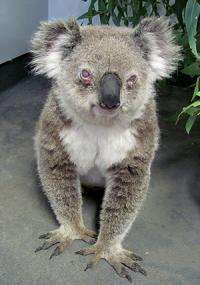The koala infected with chlamydia.
(Phys.org)—An outbreak of koala chlamydia in the Southern Highlands also poses a threat to a completely unaffected colony in Campbelltown.
The danger has been identified by the University of Sydney's Wildlife Health and Conservation Centre in Camden which is currently treating a sick animal, from the Southern Highlands area. It is one of five it has treated for a chlamydia infection in the past three years.
"The disease is infiltrating the population in the Southern Highlands which is concerning but we are even more worried that it may spread north and east into the Campbelltown population," said David Phalen, the director of the Centre, from the Faculty of Veterinary Science.
"The Campbelltown colony has an estimated 500 animals. They have been closely studied for 20 years and no evidence of chlamydia has ever been found in this healthy, growing population."
The Campbelltown koalas are important because of the genetic diversity of their immune genes.
"My research, with colleagues Damien Higgins and PhD student Quintin Lau, from the Faculty of Veterinary Science, has highlighted the importance of the Campbelltown population because it contains animals with unique genetic diversity including unique immune genes.
"We don't yet know the importance of these genes, but because koalas overall have limited genetic diversity in their immune genes loss of animals to chlamydia should be prevented.
"The koala currently being treated has a bilateral eye infection with chlamydia and it has nearly blinded her. The painful infection attacks the inside of the eyelid and the cornea, changing the cornea from clear to cloudy."
This animal is from the population 20 kilometres west of Mittagong. Koalas that have had chlamydia that have been treated at the Wildlife Health and Conservation Centre have come from the Mittagong area and from as far south as Canyonleigh (30 km further south).
"There are two species of chlamydia that infect koalas. One, Chlamydia pecorum, usually attacks the bladder and the reproductive tract. Chlamydia pneumonia usually causes the eye disease. We have seen both infections in the Southern Highland population," said Phalen.
The sick koalas are being diagnosed and treated using guidelines developed by researchers at the University of Sydney, which appear to cure the animals of infection.
Researchers Mark Krockenberger and Damien Higgins from the Faculty of Veterinary Science developed this approach to treatment in 2010 and it is now being used widely across New South Wales.
The University of Sydney Wildlife Health and Conservation Centre treats animals drawn from Sydney's south down to the Victorian border, including client owned exotic pets (rabbits, guinea pigs, birds, reptiles, and fish) and wildlife including native birds, reptiles, and mammals.
Provided by University of Sydney




















